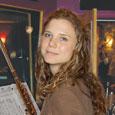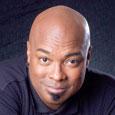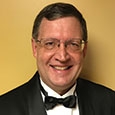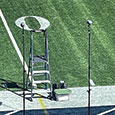I first heard Anne Drummond at the 1999 Lionel Hampton Jazz Festival where she played in Seattle’s Garfield High School Jazz Ensemble, sharing the jazz piano book and contributing some very mature, highly-crafted improvised flute solos. As a life-long jazz performer, teacher, and enthusiast, I knew she would soon emerge into the professional flute world. .jpg)
When I was invited to be an adjudicator for the 2009 festival this past February, I noticed that she was on the roster as a guest performer with Kenny Barron. She returned to the festival for the first time as a professional jazz flutist. This interview took place after her performance.
Drummond grew up in a musical family. “My father, Ian, is a classical guitarist who taught at Cornish School of the Arts in Seattle when my mother Jill was a flute student there working with Victor Case. She was even in one of my dad’s classes. Years later they married and started an early music ensemble on period instruments. This group existed until I was nine or ten and was my earliest musical influence. .jpg)
“When I was four, I begged my mother to teach me to play the flute, and somehow I ended up on a Baroque flute like hers, playing it for almost two years before switching to silver flute. At age eight I did a class report on Duke Ellington and became interested in jazz. At the same time my father taught me some blues progressions on piano, and in no time we had a piano/bass duo. My dad and I would provide an entertainment segment at my parents’ dinner parties. It wasn’t long before I was completely enamored with Bill Evan’s “Peace Piece,” Miles Davis’ “Kind of Blue,” Craig Hundley’s “Arrival of a Young Giant,” and a Duke Ellington “Greatest Hits” compilation; I remember listening to those records for hours.”
Drummond began taking bi-weekly lessons with Peter Kok, a Dutch piano teacher, who was very strict. “My parents practically stood over my shoulder when I practiced. He had me transcribing melodies and bass lines while teaching me theory and voicings. Assignments were based on simple songs, such as the theme from “Top Gun,” Bette Middler’s version of “The Rose,” “Green Onions” played by Booker T & the MGs, and the Beetles’ “Eleanor Rigby.”
“I listened to a vast number of great jazz and classical recordings, almost to the point of rejecting popular music. I realize now that my piano teacher may not have understood this because he was basing my assignments on what he thought to be more contemporary popular songs, ones he hoped would speak to a girl my age. What he didn’t realize was that fifth and sixth graders in 1993 were listening to New Kids on the Block, not the sound track to “Top Gun.” It wasn’t until high school that I acquired a more open mind with popular music, and now I listen to most everything.
“He also made me sing while accompanying myself, which contributed greatly to the development of my ear and very good relative pitch. When I took the placement exam for ear training at the Manhattan School of Music, they said I was the only one to receive a perfect score that year. I know it’s because I was working on ear development at such a young age. I don’t, however, have consistent perfect pitch.”
Drummond’s exposure to classical music was unconventional. She grew up listening to her mother practice Baroque flute and to many hours of her parents’ chamber group rehearsals. “I was drawn to classical music at a young age and entered various competitions with works by Handel, Bach, Hindemith, and Prokofiev. Even now I play Bach everyday – just for the love of it.
“Playing professionally began at an early age and was also a big part of my classical education. My sister Jayne, who is two years older, plays oboe, and we played duets whenever we could. (Jayne is now getting a masters at Rice University in oboe performance.) Together with one of my mother’s students, we started a trio called West Seattle Woodwinds that played weddings and holiday parties. I was barely 13 when we did our first wedding ceremony, and we continued working with all kinds of groups throughout our years in Seattle. I also had a weekly jazz gig at an Italian restaurant, alternating between playing piano and hiring a sax player, or bringing my flute and hiring a guitar player. During this time I also picked up the trombone and began playing it in the jazz band at Washington Middle School.” 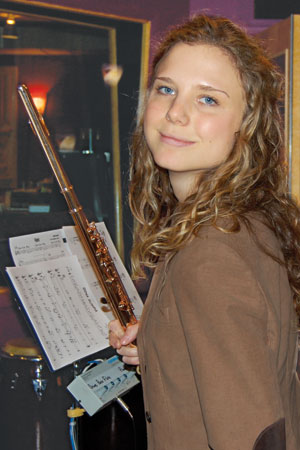
Washington Middle School and its band director Robert Knatt were a breeding ground for musicians. The school attracted an abundance of young talent and is recognized today as the launching pad for Seattle’s young thriving jazz scene. It was here that Drummond first played jazz flute.
“At the end of my eighth-grade year, I was to record the trombone solos for a school jazz band recording. When I arrived at the studio, I realized that I had left my trombone at home. I did have my flute and was talked into playing it. So my first improvised jazz flute solos are actually documented on the 1995 W.M.S. jazz band recording, Hay Burner.”
Clarence Acox was the director at Garfield High School, and like Knatt, he was from New Orleans. “They both really knew how to teach swing and the art of big band. While I was in high school, the Garfield jazz band toured Europe twice, playing the Montreux Jazz Festival and North Sea Jazz Festivals, as well as making other stops along the way to perform in places like Luxembourg and Paris. We also competed in the Essentially Ellington competition at Lincoln Center. Both Washington and Garfield schools visited most festivals around the Pacific Northwest, most notably the Lionel Hampton Jazz Festival in Moscow, Idaho.
“That festival had intense solo division competitions and awarded musical instruments as prizes. Winning students also got to perform with Lionel Hampton in an evening concert in the “Kibidome,” which seats 5,000. I competed each year on at least one and usually two instruments, and won Kurzweil keyboards and a piccolo. That festival lit a fire for me and was a wonderful motivator. Interestingly, the competition has been tamed down a bit now, but the festival itself seems to have grown. They have made a pointed effort to change the emphasis away from winning to just celebrating jazz music.”
During her high school years Drummond began studying flute with Paul Taub, who refined her playing and worked on developing her air stream and finger technique. She began to focus more on flute and piano and made the decision to quit trombone. She couldn’t wait to get to New York.
College in New York
“My New York college options for jazz were the Manhattan School of Music and The New School. There was no jazz program at Juilliard at that time. I chose Manhattan because it provided a well-rounded education, with humanities professors from Columbia, had an exceptional classical music department, and they took a very disciplined approach to music education.”
Drummond played her entrance audition on both jazz flute and jazz piano. They offered her a larger scholarship as a pianist, so she became a piano major. Her piano instructor turned out to be pianist Kenny Barron, who soon hired her to play flute in his band. “My lessons with him usually consisted of playing flute and piano duos together. Many of the Manhattan students didn’t even know that I was a piano major because they always saw me with a flute.
“However, from the beginning of freshman year, I also sought out Linda Chesis, who saw my tight smiley embouchure and worked with me to relax it for a more open sound. I played long tones in front of a mirror for a year, in a way starting over, but it was well worth the time and effort. I periodically took time off from school to go on the road and had to make up all the missed work and then some. In hindsight I realize that Manhattan was absolutely the best choice for me because they didn’t allow me to lose focus from getting my degree. You see it all the time. Students start working on the road and then often drop out. Manhattan kept me dedicated towards the degree, even when I when I was away on long leaves of absence for tours.
“The teachers were incredibly giving of their time and attention as mentors and often joined students for meals and supported our shows. I keep in touch with them to this day and return for concerts, master classes, and fundraisers.”
A Return to Idaho
That the Lionel Hampton Jazz Festival was the influential root to Drummond’s growth and development as an artist is well known, but I was curious how she felt about returning to the festival professionally. “This has been a nostalgic experience as well as a reunion with the band, Canta Brazil (Kenny Barron with Trio de Paz). This was the band that helped launch me, and I haven’t played with them in such a long time. Back then, we played and toured together so much that we were like a family. 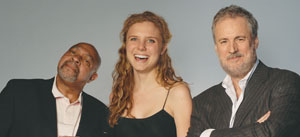
(Kenny Barron, Drummond, and bassist Nilson Matta)
“When I came all those years as a student, the festival was always in the back of my mind. On the bus coming home, I would start thinking about what I might play the following year. Getting on stage and playing with Lionel Hampton was huge. Now, some 10 years later, I am so happy to see how the festival has grown and how it is being presented. More students are interested in playing jazz, and more schools are competing. You also see more girls which is fantastic. These developments are so important as youth involvement is essential in preserving a future for jazz.”
I asked her what her thoughts were about the growing trend towards more female jazz flutists. “There are more female jazz instrumentalists across the board these days. Female jazz flutists have had more exposure and have seized the moment. I have been fortunate to have not experienced any sexism, although I have encountered a dislike for the flute itself. Some people think of jazz flute as an acquired taste and have a blanket dislike for it.
“Any negative feedback I receive from fellow jazz players is usually a reaction to the fact that I play an instrument with sonic limitations, which other musicians sometimes find creatively restrictive. Playing with a flutist requires a certain level of sensitivity from rhythm section performers. This has turned out be a critical issue when choosing musicians to play with. At the same time, however, I don’t want a drummer to automatically reach for the brushes when I walk in with a flute.”
Drummond lists her major musical influences as singers like Dinah Washington, Ester Phillips, Shirley Horn, Billy Holiday, Nancy Wilson, and Cassandra Wilson. “There is no doubt that music goes through you, so perhaps you can hear traces of them in my playing. Other musical influences include Chet Baker, Herbie Hancock, Glenn Gould, D’Angelo, James Galway, John Coltrane, Pavarotti, Oscar Peterson, Kenny Garrett, Ray Brown Trio, Ella Fitzgerald, Rampal, J.J. Johnson, Gene Harris, Ray Charles, Stan Getz, Curtis Mayfield, Aretha Franklin, Al Green, and Marvin Gaye, The composers I love passionately are Mahler, Brahms, Ravel, Debussy, Wagner, and Puccini among many others.”
Technique
“Jazz players need the facility to execute the ideas they have. I stress scales with my students: chromatic, whole tone, diminished, augmented, and every mode from Lydian to Phrygian. It’s good to learn melodies in all 12 keys, from Bach to Bebop. Transcribing solos directly to manuscript paper is also important, although it is sometimes even better to skip the notation, exercise your memory, and simply figure it out. A good way to keep from falling into the trap of playing flute ‘licks’ is to transcribe solos played on other instruments, such as guitar or trumpet solos.”
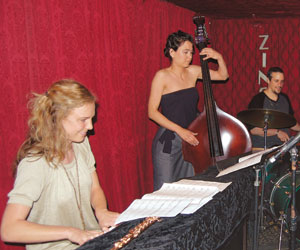
On Style
“I like to hear individuality in someone’s playing. It is important to find what is unique about your style. You have to be yourself with conviction, because anyone can copy someone else. I listen for meaning and personality and try to help students develop tools that will help them unleash their own expression. The flute is so delicate that it lends itself easily to manipulating the keys and the air for subtle nuances as well as dramatic embellishments. Slowly opening and closing the keys and actively rolling in and out are various ways to slither between notes, something I do for a seamless effect. I also use a variety of vibratos: wide and slow to shallow and fast, and so on. My vibrato shifts from diaphragm to throat to mouth – a technique not to employ in Mozart!”
Microphone Placement
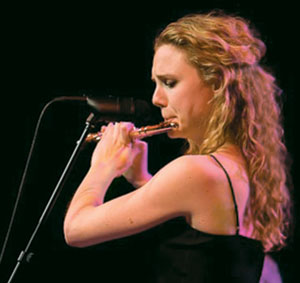 “To avoid the air stream hitting the microphone I place the mic above the headjoint and pointing downward, both in the recording studio and in live performances. In the studio I like to use old RCA ribbon mics, but not all studios have them. As for live situations, I just use what the venue offers and try not to get upset if it’s less than perfect. I used to use an attachable mic, but I didn’t like having a chord attached from a belt preamp to a PA system. I felt entangled. I may try a different setup in the future because being attached to a stationary microphone on a boom (floor mic stand) is confining as well.”
“To avoid the air stream hitting the microphone I place the mic above the headjoint and pointing downward, both in the recording studio and in live performances. In the studio I like to use old RCA ribbon mics, but not all studios have them. As for live situations, I just use what the venue offers and try not to get upset if it’s less than perfect. I used to use an attachable mic, but I didn’t like having a chord attached from a belt preamp to a PA system. I felt entangled. I may try a different setup in the future because being attached to a stationary microphone on a boom (floor mic stand) is confining as well.”
On Tone
“I like to think of my sound as an extension of my singing voice. If Ella Fitzgerald were singing through a flute, what would that sound like? An excellent example is Chet Baker, who demonstrates stylistic continuity between his trumpet and voice. An even better example is Ian Anderson, who unabashedly demonstrates his individualistic and virtuosic side.
“Sometimes I just start a paractice session by putting on James Galway or Pavoratti recordings, or someone with moving air whose vibrato I fancy, and just practice along with them. If my sound is slow to develop that day, I move to singing-while-playing exercises.”
I asked if she was interested in wooden and various ethnic flutes. “No, not really, but I have a wooden headjoint that has a wailing quality – in a good way. I love my alto flute, even though it’s not putty in my fingers like my C flute. No one would disagree that the sonorous sound is absolutely gorgeous on alto. The last recording I did with Kenny Barron I played it almost exclusively.” She remarks that piccolo is something she never had much interest in. “I played piccolo recently for the first time on a recording, but I only practiced it the day before the session.” Laughing she adds, “it wasn’t very good.”
Advice for Students
“There is no one formula for those pursuing jazz. The best thing you can do is focus on your musicianship and develop skills that will help the development of your music. Those skills might include learning a notation program or studying orchestration. The more perspective and abilities the better. It’s important to learn standards like “I Got Rhythm” and “There is No Greater Love” because that is the common language in jazz. Last year I did a show in Madagascar with local musicians who spoke absolutely no English, but it was a wonderful performance. What made it great was that we didn’t need to read charts as we played tunes we all knew like “Days of Wine and Roses” and “Summertime.”
“When I go to really learn a standard, I practice the melody in every key, and I also study the lyrics. To me it’s like eating my vegetables.”
Plans for the Future
Drummond admits that developing as a composer is at the forefront these days. “I have a strong desire to do much more writing. I have many sides as a composer and ideally I’d like to incorporate them all into one show, to be executed by one stylistically versatile band. That’s just one vision I have for myself, others are still forming in the works.”
Drummond’s debut solo recording, Like Water, features flute and alto flute in an instrumental setting that includes a string quartet and a Brazilian rhythm section. She is excited about the release of the recording for the obvious reasons but also views it as a point of departure for new projects. “Like Water was recorded two years ago, but it feels like two lifetimes ago and I’m itching to do more. I am however pleased that this record captured a great musical chapter of my life. On it, my music is played by superbly talented friends. As always we had a ball recording and you can hear that fun through the music.”
